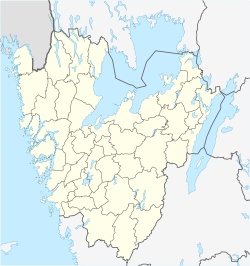Marstrand
Marstrand | |
|---|---|
| Coordinates: 57°53′N 11°35′E / 57.883°N 11.583°E | |
| Country | Sweden |
| Province | Bohuslän |
| County | Västra Götaland County |
| Municipality | Kungälv Municipality |
| Area | |
• Total | 0.88 km2 (0.34 sq mi) |
| Population (31 December 2010)[1] | |
• Total | 1,319 |
| • Density | 1,507/km2 (3,900/sq mi) |
| Time zone | UTC+1 (CET) |
| • Summer (DST) | UTC+2 (CEST) |

Marstrand (Swedish pronunciation: [ˈmâʂːtrand])[2] is a seaside locality situated in Kungälv Municipality, Västra Götaland County, Sweden. It had 1,320 inhabitants in 2010.[1] The town got its name from its location on the island of Marstrand. Despite its small population, for historical reasons Marstrand is often referred to as a city. The town has expanded to the neighbouring island of Koön, which has bridge access to the mainland.
The city had free port status, which was declared by King Gustav III,[3] from 1775 to 1794.[4] Religious liberty established by the same sovereign allowed the first Swedish congregation of Jews to be established there in 1775[5] and Scandinavia's first synagogue to be set up in the fortress in 1780. Making it a notable site to the history of the Jews in Sweden.
Following the abolishment of the free port status and the decline of herring fishing, Marstrand established itself as a seaside resort in the 19th century.[6]
Important annual sporting events held in Marstrand include the Stena Match Cup Sweden and Marstrand Regatta. Marstrand is known as a playground for celebrities and wealthy Swedish residents alike, who come in the summer for the sea, shopping and the nightlife.[7]
History
Kalmar Union 1397–1537
Denmark–Norway 1537–1658
Sweden 1658–1775
Marstrand Free Port 1775–1794Sweden–Norway 1814–1905
Sweden 1905–present
Marstrand has held city privileges since 1200. The most striking feature of Marstrand is the 17th-century fortress Carlsten, named for King Carl X Gustav of Sweden.
During the last quarter of the 18th century Marstrand had free port status[8] granted by King Gustav III.
In the 1790s, the Jewish inhabitants of Marstrand numbered around 60 individuals at its peak Jewish population time. In 1805, all the Jews, except for one family, had left Marstrand for Gothenburg.[9] Notable families of the Marstrand Jewish community were the Henriques, Delbanco, Warburg, von Reis and Magnus families.[10]
Administratively Marstrand with immediately surrounding islands was a municipality of its own until the local government reform of 1971 when it was merged into Kungälv Municipality.
In 1969, around 200 stateless Polish Jews arrived there.[11][12]
Sports
Sailing
Being an island makes Marstrand popular for sailing and boat races.
Marstrand is the host venue for Match Cup Sweden, part of the World Match Racing Tour. The event draws international sailing teams to Marstrand. DS-37 boats are raced two at a time. Points accrued count towards the World Match Racing Tour and a place in the final event, with the overall winner taking the title ISAF World Match Racing Tour Champion. Match racing is well suited to Marstand. Highlights of the events are broadcast on Eurosport television and via the official World Match Racing Tour website.[citation needed]
See also
Sister cities
References
- ^ a b c "Tätorternas landareal, folkmängd och invånare per km2 2005 och 2010" (in Swedish). Statistics Sweden. 14 December 2011. Archived from the original on 27 January 2012. Retrieved 10 January 2012.
- ^ Jöran Sahlgren; Gösta Bergman (1979). Svenska ortnamn med uttalsuppgifter (in Swedish). p. 17.
- ^ Holmberg, Axel Emanuel (1867). Bohusläns historia och beskrifning: Tjörn, Inland och Hisingen (in Swedish). Lindh. p. 201 – via Google Books.
1775 utfärdades ock från Ekolsund den märkvärdiga författning, hvarigenom konung Gustaf III förklarade Marstrand för en Porto Franco med de mest vidsträckta friheter.
- ^ "Hit seglade judarna!" (in Swedish). Jewish Museum of Sweden. Retrieved 1 August 2022.
- ^ Pages by the Swedish Tax Authority on historical congregations
- ^ Hofberg, Herman (1882). Genom sveriges bygder: Skildringar af vart land och folk ... Ny, genomsedd och tillokad upplaga ... (in Swedish). A. Bonniers förlag. p. 216 – via Google Books.
- ^ "15 Most Charming Small Towns in Sweden".
- ^ Krantz 1950, p. 61.
- ^ "Göteborgs judiska historia" [Gothenburg's Jewish History]. www.judiskaforsamlingen.se (in Swedish). Judiska Församlingen Göteborg. Retrieved 1 August 2022.
- ^ Krantz 1950, p. 70.
- ^ Grinzweig Jacobsson, Anna. "Hösten då judarna kom till Marstrand". Göteborgs-Posten (in Swedish). Retrieved 24 August 2022.
- ^ "Flykten till Marstrand". goteborgsstadsmuseum.se (in Swedish). Retrieved 24 August 2022.
Literature
- Jonason, Aron (1908). Drottminnen från Marstrand (in Swedish) – via Project Runeberg.
- Olán, Eskil (1917). Marstrands historia, krigsminnen och badortslif (in Swedish). Lundbergs Boktryckeri.
- Krantz, Claes (1950). Marstrand, med teckningar av författaren (in Swedish). Wahlström & Widstrand.
- Aasma, Karin (1974). Kyrkorna i Marstrand (in Swedish). Vol. 4. Almqvist & Wiksell. ISBN 9789171921543.
- Olsson, Louise (2013). Marstrand 32 inom Marstrand 5:6 Marstrands socken, Kungälv kommun (in Swedish). Rio Göteborg Natur- och kulturkooperativ. ISBN 9789188481153.
- Ernby, Eibert (2016). Marstrand under porto francotiden (in Swedish). Vulkan. ISBN 9789188481153.
- Grinzweig Jacobsson, Anna (2020). Flykten till Marstrand (in Swedish). Korpen. ISBN 9789188383792.
External links
- Marstrand - From Kungälv Municipality official page
- (in Swedish) article Marstrand from Nordisk Familjebok (1912)





